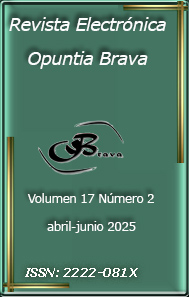Disruptores endocrinos: Un riesgo en la salud reproductiva de las mujeres
Palabras clave:
Disruptores endocrinos, salud reproductiva, exposición, efectos hormonales, trastornos hormonales, evaluación de riesgos.Resumen
Los disruptores endocrinos (DE) son sustancias que tienen actividad hormonal y se encuentran en el medio ambiente. Tienen la capacidad de interferir con varios procesos fisiológicos en humanos y animales, afectando sistemas como el nervioso central, el endocrino, el óseo y el inmunológico. El objetivo de la investigación es evaluar el impacto de los disruptores endocrinos en la salud reproductiva de las mujeres. La metodología consistió en un estudio de carácter bibliográfico, para ello se utilizó diversas bases de datos de relevancia en el ámbito médico y científico; incluyen PubMed, Embase, Cochrane Library, Web of Science, Scopus, LILACS, y Google Scholar. Los disruptores endocrinos interfieren con este sistema al imitar, bloquear o alterar la producción, liberación, transporte o eliminación de las hormonas naturales. En conclusión la exposición a disruptores endocrinos representa una preocupación significativa debido a su capacidad para interferir con el sistema endocrino, crucial para la regulación hormonal y la salud reproductiva en humanos.
Descargas
Citas
Aguinsaca, K. F. P., Molina, E. P. A., Hernández, J. P. C., Romero, M. A. C., Reinoso, S. A. O. & Sarmiento, C. E. S. (2023). La influencia de los disruptores endocrinos y su interacción con el organismo. Brazilian Journal of Health Review, 6(1), 569–587. https://doi.org/10.34119/bjhrv6n1-046. https://ojs.brazilianjournals.com.br/ojs/index.php/BJHR/article/view/56145.
Anwar, M. Y., Marcus, M. & Taylor, K. C. (2021). The association between alcohol intake and fecundability during menstrual cycle phases. Human reproduction (Oxford, England), 36(9), 2538–2548. https://doi.org/10.1093/humrep/deab121
Cho, Y. J., Yun, J. H., Kim, S. J. & Kwon, H. Y. (2019). Nonpersistent endocrine disrupting chemicals and reproductive health of women. Reproductive Endocrinology Obstetrics & Gynecology Science, 63(1), 1-12. https://doi.org/10.5468/ogs.2020.63.1.1
Duursen, M. B. M. V., Boberg, J., Christiansen, S., Connolly, L., Damdimopoulou, P., Filis, P., Fowler, P. A., Gadella, B. M., Holte, J., Jääger, K., Johansson, H. K. L., Li, T., Mazaud-Guittot, S., Parent, A. S., Salumets, A., Soto, A. M., Svingen, T., Velthut-Meikas, A., Wedebye, E. B.,
Xie, Y., & Berg, M. V. D. (2020). Safeguarding Female Reproductive Health against Endocrine Disrupting Chemicals-The FREIA Project. International journal of molecular sciences, 21(9), 3215. https://doi.org/10.3390/ijms21093215
Guamán Cango, M. del C. y Mejia Campoverde, L. H. (2023). Infertilidad asociada a endometriosis. Revisión bibliográfica. Salud ConCiencia, 2(2), e24. https://doi.org/10.55204/scc.v2i2.e24
Karwacka, A., Zamkowska, D., Radwan, M. & Jurewicz, J. (2019). Exposure to modern, widespread environmental endocrine disrupting chemicals and their effect on the reproductive potential of women: an overview of current epidemiological evidence. Human fertility (Cambridge, England), 22(1), 2–25. https://doi.org/10.1080/14647273.2017.1358828
Kawa, I. A., Akbar Masood, Fatima, Q., Mir, S. A., Jeelani, H., Manzoor, S. & Rashid, F. (2021). Endocrine disrupting chemical Bisphenol A and its potential effects on female health. Diabetes Metabolic syndrome, 15(3), 803–811. https://doi.org/10.1016/j.dsx.2021.03.031
Kyvsgaard, J. N., Chawes, B. L., Horner, D. L. G., Hesselberg, L. M., Melgaard, M. E., Jensen, S. K., Schoos, A. M., Thorsen, J., Pedersen, C. T., Brustad, N., Bønnelykke, K., Bisgaard, H., & Stokholm, J. (2023). Risk Factors and Age-Related Patterns of Asthma-Like Symptoms in Early Childhood. The journal of allergy and clinical immunology. In practice, 11(6), 1773–1784.e10. https://doi.org/10.1016/j.jaip.2023.02.031
Li, Q., Zheng, D., Wang, Y., Li, R., Wu, H., Xu, S., Kang, Y., Cao, Y., Chen, X., Zhu, Y., Xu, S., Chen, Z. J., Liu, P., & Qiao, J. (2021). Association between exposure to airborne particulate matter less than 2.5 μm and human fecundity in China. Environment international, 146, 106231. https://doi.org/10.1016/j.envint.2020.106231
Lin, J., Lin, X., Qiu, J., You, X., & Xu, J. (2023). Association between heavy metals exposure and infertility among American women aged 20-44 years: A cross-sectional analysis from 2013 to 2018 NHANES data. Frontiers in public health, 11, 1122183. https://doi.org/10.3389/fpubh.2023.1122183
Martínez Bebiá, M. (2022). Valoración nutricional y su relación con la exposición a disruptores hormonales en población universitaria del sur de España. [Tesis doctoral, Universidad de Murcia]. https://dialnet.unirioja.es/servlet/tesis?codigo=315269
Morocho Quinchuela, F., Valverde González, C. y Sánchez Garrido, A. (2023). Asociación del bajo peso al nacer con la prematuridad, el hábito de fumar, la infección y la hemorragia. Revista Cubana de Investigaciones Biomédicas, 42(2). https://revibiomedica.sld.cu/index.php/ibi/article/view/2994
Navarro Lafuente, F. (2023). Exposición materna a disruptores endocrinos no persistentes y biomarcadores de salud perinatal. [Tesis doctoral, Universidad de Murcia]. https://dialnet.unirioja.es/servlet/tesis?codigo=317131
Organización Mundial de la Salud (2013). Nuevo informe sobre las sustancias químicas que perturban la función endocrina. https://www.who.int/es/news/item/19-02-2013-effects-of-human-exposure-to-hormone-disrupting-chemicals-examined-in-landmark-un-report
Piazza, M. J. & Urbanetz, A. A. (2019). Environmental toxins and the impact of other endocrine disrupting chemicals in women's reproductive health. JBRA assisted reproduction, 23(2), 154–164. https://doi.org/10.5935/1518-0557.20190016
Rattan, S. & Flaws, J. A. (2019). The epigenetic impacts of endocrine disruptors on female reproduction across generations. Biology of reproduction, 101(3), 635–644. https://doi.org/10.1093/biolre/ioz081
Rodríguez Bautista, E. y Rodríguez Charry, L. (2022). Disruptores endocrinos presentes en perfumes y su efecto en la salud humana. [Tesis de pregrado, Universidad Colegio Mayor de Cundinamarca]. https://repositorio.unicolmayor.edu.co/bitstream/handle/unicolmayor/6519/MONOGRAFIA%20DE%20PERFUES%20ULTIMA%20VERSION.pdf?sequence=11&isAllowed=y
Wang, B., Zhou, W., Zhu, W., Chen, L., Wang, W., Tian, Y., Shen, L. & Zhang, J. (2018). Associations of female exposure to bisphenol A with fecundability: Evidence from a preconception cohort study. Environment International, 117, 139-145. https://doi.org/10.1016/j.envint.2018.05.003
Wesselink, A. K., Kirwa, K., Hatch, E. E., Hystad, P., Szpiro, A., Kaufman, J., Levy, J., Mikkelsen, E., Quraishi, S., Rothman, K. & Wise, L. (2020). Residential proximity to major roads and fecundability in a preconception cohort. Environmental Epidemiology, 4(6), e112. https://10.1097/EE9.0000000000000112
Wu, C., Xin, X. & Chen, J. (2023). Vitamin D Intake Attenuated the Association between Pesticides Exposure and Female Infertility. Clinical laboratory, 69(9). https://doi.org/10.7754/Clin.Lab.2023.230201
Xiufang, G., Shuang, K., Rongwei, X. & Ming, C. (2020). Environment-Friendly Removal Methods for Endocrine Disrupting Chemicals. Sustainability MDPI, 12(18), 7615. https://ideas.repec.org/a/gam/jsusta/v12y2020i18p7615-d414078.html
Zúñiga-Venegas, L., Saracini, C., Pancetti, F., Muñoz-Quezada, M. T., Lucero, B., Foerster, C. y Cortés, S. (2021). Exposición a plaguicidas en Chile y salud poblacional: urgencia para la toma de decisiones. Gaceta Sanitaria, 35(5), 480-487. https://dx.doi.org/10.1016/j.gaceta.2020.04.020



































































